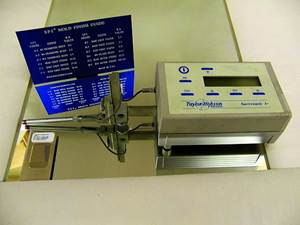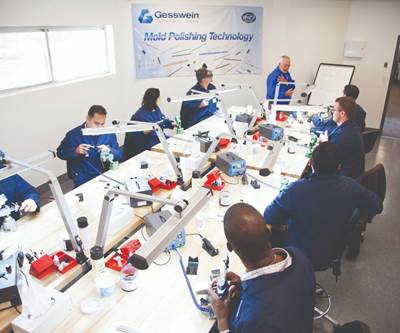Every shop wants to increase productivity, and polishing is often the bottleneck. Although companies understand the value of polishing, many are not willing to deal with polishing because they do not know how to do it properly.
Polishing longer is not always the answer. Steve Smith, Gesswein & Co. polishing coach, says that the answer is more polishers. His experience has taught him that there should be one polisher for every ten people cutting steel. “So, if you have a 100-man shop cutting steel and programming, then you need ten polishers to keep up. Most shops would have three,” Smith says. He also stands by a 10-hour work day. Smith believes that nine hours is optimal, as a polisher’s fingers can only take so much of the vibration and abrasiveness associated with polishing.
Machining Effect
Despite the lack of skilled labor, today’s shops seem to have enough polishers, but they have a weakness in their machining. They are feeding polishers work that takes them too long, which yields parts that do not comply with the print because the polishers removed too much material. “Polishers must meet tolerances on molding areas, or they must scrap the part, but the amount of material a polisher removes depends on what the machinist puts in,” Smith says. The quality of the part that the machinist gives to the polisher determines the amount of time that the polisher spends polishing that part. The longer the polisher polishes, the more likely it is that the polisher changes the shape of the part.
The secret to improving polishing efficiency and part quality is improving the front end, or what is coming into the polishing department. For example, high-speed machining and EDM have advantages in accuracy, speed and surface finish, but these benefits can complicate polishing, requiring polishers to rethink how they polish.
A common polishing challenge is removing the EDM recast layer and the hard layer that high-speed machining creates. Even though high-speed machining produces a surface that is shiny and very fine, there is a layer of really hard steel that reveals the pattern of the cutter when it is polished. If the polisher does not remove the pattern completely, the pattern will still be visible. According to Smith, the key to fixing this is “getting below that layer.”
The very fine surface that high-speed machining produces also entices polishers to start off with a 600- or 900-grit stone. However, polishers realize quickly that they must remove that hard layer first, which means that the soft, finer stones will not work. It is better to begin with a 400-grit stone. Basically, this hard layer requires an abrasive stone, but as polishers remove the hard layer, they start to scratch the softer steel, ripping and tearing the steel as they get through the hard layer. So, although high-speed machining benefits the machinist with cutting, that process does not help the polisher.
For EDM, the hard spot particles can sometimes flip out as the polisher works on the surface, leaving a big pit. Other times, operators finish grinding an area and then use EDM over the grind area until it sparks out to match. Those EDM pits are then below the grind surface. “It's counterproductive,” Smith says.
Another example is when machinists do not provide enough overlap with the finisher to remove all of the roughing burn. This requires the polisher to remove deep pits and the recast layer below if the goal is a good polish.
Today, polishers need to learn how to work with these surfaces differently. Experience and having the ability to gauge how much material the polishing removes are essential. The answer is training and practice. If a polisher only polishes something once a month as a minor part of the job, the polisher is never going to become proficient at polishing.
The secret to improving polishing efficiency and part quality is improving the front end, what's coming into the polishing department.
Learning Culture
Another aspect of polishing proficiency is creating a culture of learning. “You need a culture of learning to figure out different polishing strategies and to troubleshoot the cause of a condition,” Smith says.
Polishers need experience and common sense to solve problems and to do things faster and more efficiently. This means learning from mistakes and successes and building that experience into documented strategies.
Smith suggests taking a 3D print of the part, inserting an arrow on the surface and noting what was done to achieve the surface finish. He says not to focus on individual steps. Instead, focus on the actual finish because the finish that the machinist provides to the polisher determines the starting point for the polisher. The process is what the polisher uses to achieve the customer’s required surface finish. The customer might specify the tool or the method, but not the process.
“Take, for example, the SPI A1 finish from a felt buff. Ask yourself—How are you using that felt? Are you doing it by hand, on a machine, etc.? If you are using a machine, you need to understand that different speeds will give you different shines. Are you using hard felt or soft felt? All of this is part of your internal strategy for each project,” Smith says.
That being said, polishers should not document their processes for the customer, Smith says, because it will lock them into a particular process. An example is heat-treating steel. Just one point from 50 to 51 can make a difference in how a polisher works on that job. This does not sound significant, but it is. A hardness range from 48 to 52 is a whole world of difference in polishing to the polisher from one part to another. “So, if you have parts that are 48 and others that are 52, the polisher is going to polish differently,” Smith says.
As long as the shop is achieving the customer’s desired finish, polishing documentation is for internal purposes only. How the polisher goes about it is the shop’s proprietary information.
“For example, we had a syringe mold, and the customer wanted to mold polypropylene, which polishes well with a 600-grit stone or a light-glass bead. But, this gave a frosted part, and the customer wanted to be able to see through the syringe. We had parts sticking in the mold. Our solution was first to draw-stone the part (the direction the part pulled off). We then bead-blasted it and brushed it with diamond compound,” Smith says. This polishing process was documented internally to improve his shop's polishing efficiency.
If shops want to produce a quality part every time, they should establish an environment for learning that includes internal process documentation. In the end, that will help polishers overcome challenges such as the impact of HSM and EDM on polishing. “How you do it is up to you. Just keep practicing,” Smith says.
Related Content
Surface Finish: Understanding Mold Surface Lingo
The correlation between the units of measure used to define mold surfaces is a commonly raised question. This article will lay these units of measure side by side in a conversion format so that companies can confidently understand with what they are dealing.
Read More5 Hot Runner Tips for Moldmakers and Molders
Best practices for initial hot runner tryouts and effective preventive maintenance.
Read MoreMachine Hammer Peening Automates Mold Polishing
A polishing automation solution eliminates hand work, accelerates milling operations and controls surface geometries.
Read MoreRead Next
Polishing Requires Local-Level Communication
A focus on machining and measuring when polishing saves time and improves part quality.
Read MoreReasons to Use Fiber Lasers for Mold Cleaning
Fiber lasers offer a simplicity, speed, control and portability, minimizing mold cleaning risks.
Read MoreHow to Use Continuing Education to Remain Competitive in Moldmaking
Continued training helps moldmakers make tooling decisions and properly use the latest cutting tool to efficiently machine high-quality molds.
Read More













.jpg;maxWidth=300;quality=90)









